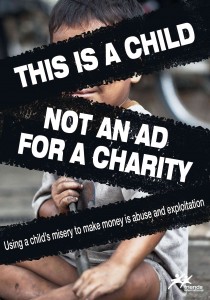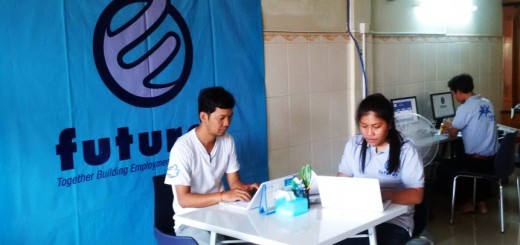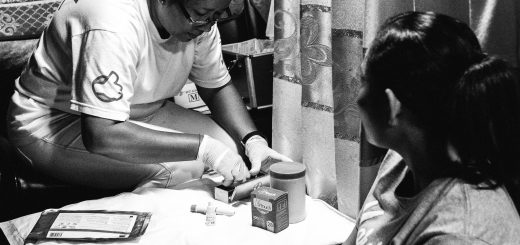THINK! Pity Charity – why it’s actually abusive to children…
(Originally published in October 2013, this thought-provoking piece on the use of Pity Charity in fundraising comes from the Executive Director of Friends-International, Sebastien Marot.)
‘Over the last week two separate shocking stories emerged from Cambodia:
A globally renowned organization was again accused of faking stories used in international TV and other international media to raise funds and awareness about the organization;
A local “orphanage” organized an auction of photos of children and had the children present their own photos while their life-story was made public to the audience in order to increase pity (and sales).
These separate events are a direct consequence of the interconnected actions of the child protection organizations, the media, the donors and the general public; all wanting the best for these children, but instead turning them into victims.
-The Child Protection Agencies: a large number of organizations get sucked into using children to raise funds: making them talk about the abuse they survived in front of a camera, having their picture in a pitiful situation published for everyone to see, allowing non-professional visitors into their centers (like orphanage tourism). In worst cases, the truth is distorted or the stories invented to attract more compassion and money.
The impact on the lives of these children is terrible: if they come from an abusive situation, such a process re-traumatizes them and in any case it stigmatizes them forever. As one such victim explains in an article exposing the practice: “You know, my reputation has been lost because of this video (…). Everybody looks down on me.”
These organizations are to blame: their primary role is to protect these children from abuse and re-abuse and to support them to build futures. This often means giving them a clean slate, erasing the negative past and not making it an on-going reality. However, one must recognize that these organizations are more than often trying to function and ensure the income they need to provide services in an environment hungry for emotional stimulus.
–The role of Mainstream Media: media needs to report on situations and at the same time it needs sensationalism to feed the public, to secure high audience ratings, attract advertisers… in order to easily achieve this, it is tempting to use the most emotionally charged visuals and stories and what better than a suffering child? Even better from their point of view if the child is directly suffering or crying whilst telling about his/her ordeal?
The current trend you hear everywhere is “Tell stories!”; this easily reinforces the tendency to take the short cut of having people and children tell their stories.
Regularly we have media teams coming to Friends-International, pushing for those kind of stories, many boasting their own “child protection” policies, which they then attempt to disregard. The temptation to attract funding through this is obviously high, but as we have learned our lessons and have devised a strong policy that protects the children, we refuse; which means that we miss on visibility and possible funding.
–The role of Donors: many donors play an integral role in this issue. As regulators of the money it is easy, if specific guidelines are not in place, to fund projects on a purely emotional basis. For example we have witnessed a rapid increase of orphanages in Cambodia (funded by local and foreign private donors), despite the fact that most of these children are not orphans and it is against current Cambodian Government policies. Like the general public, donors react to highly emotionally charged stories that in some cases are built to please them or are told at the expense of the same children they want to protect. Many donors do not have the capacity or desire to check these stories, so we end up in situations of “embellished” story lines.
A main consequence of this is that in some instances organizations end up selling the wrong problem to the donors: since donors will fund based on emotions and not on the more mundane facts, this can lead to the creation of programs built on entirely wrong assumptions which do not provide the right solutions to the beneficiaries. They may give the ‘right’ message / image back to the donors but end up further hurting the children with the money that was intended to protect them.
–The General Public: organizations, media and even donors are trying to get the approval of the general public. This is exacerbated by the explosion of social media where people can react immediately and create large opinion movements in a very short time.
Obviously we are all more reactive and sensitive to a good and emotional story and an increasing number of these are coming our way, each trying to outdo the other in creating even more emotionally charged content. As we can now react immediately, there is less and less time to check the veracity or provide analysis for these stories before they become viral. Increasingly people are invited to vote for the best projects that in turn will get money: this can easily turn into a pity competition, where children become the victims for a crowd hungry for good stories. The money raised can indeed go to good projects, but at what expense?
At Friends-International, we try to provide a different approach: we talk about the work and the results, we try to give background information without using individual children (my core presentation is indeed a case study, but totally fabricated from different cases and the photos are our staff acting: this is not a secret).
Yes, over the years we have made mistakes, but we have learned from these and reinforced our Child Protection Policies and our Media Guidelines.
In truth it is difficult to resist the visibility that can attract the funding we need to maintain programs that will then, in turn, provide the support these children and families so desperately need. Basically, we realize that the way we communicate makes people think we do not need support and that we are well funded. In any case we generate less interest compared to organizations with high media visibility.
This said, we believe that it is a small price to pay for integrity and for providing the protection that is at the core of our mission.
What is very encouraging is that we are not the only ones: the number of organizations establishing and enforcing stricter standards is rapidly increasing. We see donors starting to review their policies and practices and we are starting to see on social media people asking difficult questions. A movement has started and it needs to be nurtured by everyone.
It’s an essential move that needs to be led by the general public and donors: say no to sensationalism, look at what is really happening and the complexity of issues involved, be interested and not just emotionally driven… this is a very difficult change in behavior. In many ways the ball is in the donor’s (big and small) court: they should be the ones leading so that organizations do not feel compelled to distort truth to receive funding…
This said, ultimately, organizations must hold to their protection policies above all else. As more cases of abusive stories (abusing the child, the donors and the audience) are emerging, these discredit the entire field, damage everyone’s work and again ultimately harm the children.
Shifting attitudes is difficult but at the same time it is the right thing to do.
Do it – join the Movement!’









Thank You Sebastien. It took me a while to “get it” but now I’m on THE campaign.
Thank you, Sebastian, for the courage to pioneer this movement
Why are the Organizations not named in the Artical?
Thank you for your comment. It should be noted that this is an opinion piece, not reportage, which is why no organizations are specifically named in the text.